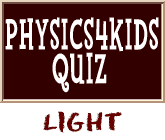Types of Light
To understand light you have to know that what we call light is what is visible to us. Visible light is the light that humans can see. Other animals can see different types of light. Dogs can see only shades of gray and some insects can see light from the ultraviolet part of the spectrum. The key thing to remember is that our light is what scientists call visible light.Scientists also call light electromagnetic radiation. Visible light is only one small portion of a family of waves called electromagnetic (EM) radiation. The entire spectrum of these EM waves includes radio waves, which have very long wavelengths and both gamma rays and cosmic rays, which are at the other end of the spectrum and have very small wavelengths. Visible light is near the middle of the spectrum.
It's all Energy
The key thing to remember is that light and EM radiation carry energy. The quantum theory suggests that light consists of very small bundles of energy/particles; it's just that simple. Scientists call those small particles photons, and the wavelength determines the energy and type of EM radiation, and the number of photons tells you how much radiation there is. A lot of photons give a brighter, more intense type of light. Fewer photons give a very dim and less intense light. When you use the dimmer switch on the wall, you are decreasing the number of photons sent from the light bulb. The type of light is the same while the amount has changed.Different Speeds of Light?
As far as we know, all types of light move at one speed when in a vacuum. The speed of light in a vacuum is 299,792,458 meters per second. That speed is really fast, but even when you're traveling that fast, it takes a while to get places in space. It takes about seven minutes for light from the Sun to reach Earth. It takes over four years for the light from our Sun to get to the nearest star. It would take a particle of light over 100,000 years to get from one side of our galaxy to the other side. All of those values are light moving through a vacuum. You can slow light down in other substances such as the atmosphere, water, or a diamond. Light moves at about 124,000,000 meters per second (less than half the speed in a vacuum) in a diamond.
Or search the sites for a specific topic.
Tour the EM Spectrum (ScienceAt NASA Video)

Useful Reference Materials
Encyclopedia.com (Light):http://www.encyclopedia.com/topic/light.aspx
Encyclopedia.com (Optics):
http://www.encyclopedia.com/topic/optics.aspx
Wikipedia (Light):
http://en.wikipedia.org/wiki/Light
Wikipedia (Optics):
http://en.wikipedia.org/wiki/Optics
Encyclopædia Britannica (Optics):
http://www.britannica.com/EBchecked/topic/430511/optics






